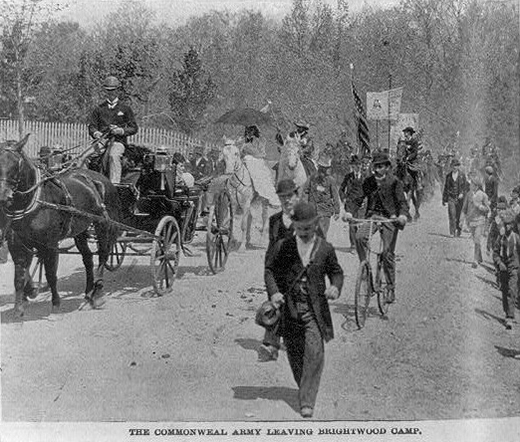| << Chapter < Page | Chapter >> Page > |
A notable example of the government’s failure to act was the story of Coxey’s Army . In the spring of 1894, businessman Jacob Coxey led a march of unemployed Ohioans from Cincinnati to Washington, DC, where leaders of the group urged Congress to pass public works legislation for the federal government to hire unemployed workers to build roads and other public projects. From the original one hundred protesters, the march grew five hundred strong as others joined along the route to the nation’s capital. Upon their arrival, not only were their cries for federal relief ignored, but Coxey and several other marchers were arrested for trespassing on the grass outside the U.S. Capitol. Frustration over the event led many angry works to consider supporting the Populist Party in subsequent elections.
Scholars, historians, and economists have long argued inconclusively that L. Frank Baum intended the story of The Wizard of Oz as an allegory for the politics of the day. Whether that actually was Baum’s intention is up for debate, but certainly the story could be read as support for the Populist Party’s crusade on behalf of American farmers. In 1894, Baum witnessed Coxey’s Army’s march firsthand, and some feel it may have influenced the story ( [link] ).

According to this theory, the Scarecrow represents the American farmer, the Tin Woodman is the industrial worker, and the Cowardly Lion is William Jennings Bryan, a prominent “Silverite” (strong supporters of the Populist Party who advocated for the free coinage of silver) who, in 1900 when the book was published, was largely criticized by the Republicans as being cowardly and indecisive. In the story, the characters march towards Oz, much as Coxey’s Army marched to Washington. Like Dorothy and her companions, Coxey’s Army gets in trouble, before being turned away with no help.
Following this reading, the seemingly powerful but ultimately impotent Wizard of Oz is a representation of the president, and Dorothy only finds happiness by wearing the silver slippers—they only became ruby slippers in the later movie version—along the Yellow Brick Road, a reference to the need for the country to move from the gold standard to a two-metal silver and gold plan. While no literary theorists or historians have proven this connection to be true, it is possible that Coxey’s Army inspired Baum to create Dorothy’s journey on the yellow brick road.
Several strikes also punctuated the growing depression, including a number of violent uprisings in the coal regions of Ohio and Pennsylvania. But the infamous Pullman Strike of 1894 was most notable for its nationwide impact, as it all but shut down the nation’s railroad system in the middle of the depression. The strike began immediately on the heels of the Coxey’s Army march when, in the summer of 1894, company owner George Pullman fired over two thousand employees at Pullman Co.—which made railroad cars, such as Pullman sleeper cars—and reduced the wages of the remaining three thousand workers. Since the factory operated in the company town of Pullman, Illinois, where workers rented homes from George Pullman and shopped at the company store owned by him as well, unemployment also meant eviction. Facing such harsh treatment, all of the Pullman workers went on strike to protest the decisions. Eugene V. Debs, head of the American Railway Union, led the strike.

Notification Switch
Would you like to follow the 'U.s. history' conversation and receive update notifications?